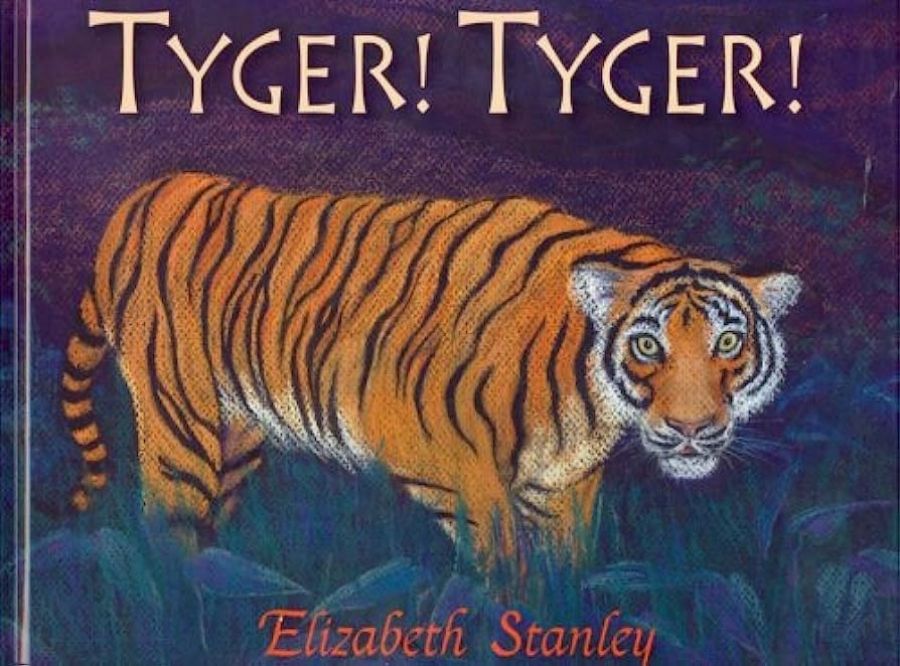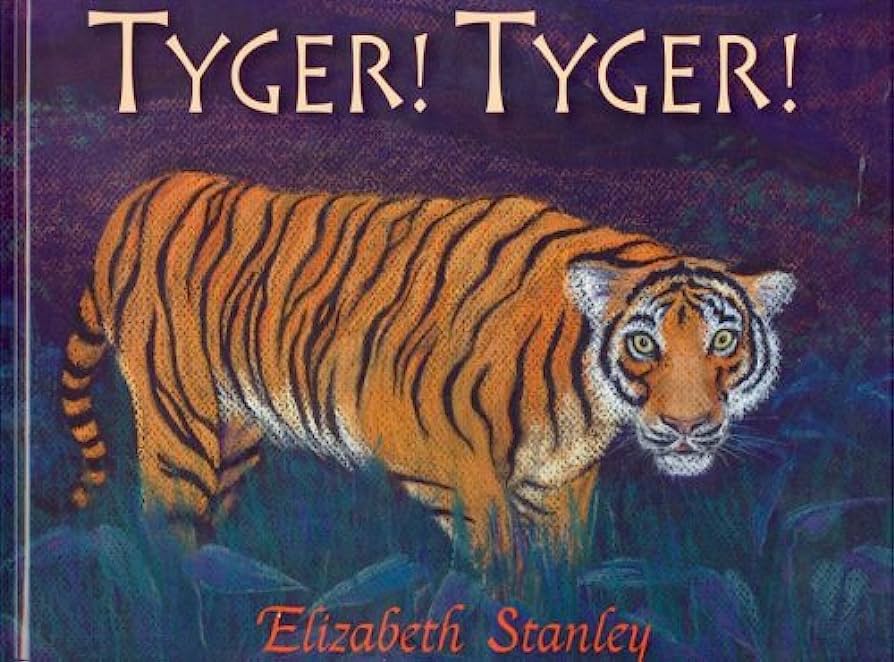
- Free Article: No
- Contents Category: Picture Books
- Review Article: Yes
- Article Title: With Feeling
- Online Only: No
- Custom Highlight Text:
Once upon a time, identifying a good picture book was simple: it had bright-coloured illustrations, an easy-to-read text, and it dealt with things relevant to a child’s life. While these elements are still important, the genre has developed to such an extent that simplicity is no longer the prime criterion. As some recent titles show, picture books can cover a multitude of styles and themes; however, whatever their subject, the overriding criteria should always be artistic and literary excellence, and an ability to touch the reader.
- Book 1 Title: Tyger! Tyger!
- Book 1 Cover Small (400 x 600):

- Book 1 Cover (800 x 1200):

A True Person (New Frontier Publishing, $24.95 hb, 32 pp), by Gabiann Marin and Jacqui Grantford, also deals with a serious subject. It relates the tale of Zallah and her mother, who escape from their country on an overcrowded boat and end up in an Australian detention centre. The term ‘true person’ technically means someone who has papers to prove their identity, but this book shows that it has deeper meanings. While Marin’s text is competently written, Grantford has been more innovative in her illustrative response. Although her style is representational, her layout is interpretative, providing a fresh approach to the manipulation of the picture book space. While this does not always work, and while a subtler approach to storytelling would have produced a stronger text, there is still much to beguile in A True Person.
Ken Searle includes multiple images on a page as he mixes photographs, hand-drawn maps and children’s drawings with Nadia Wheatley’s text for Going Bush (Allen & Unwin, $29.95 hb, 32 pp). While the result is somewhat busy, it provides much material for children to pore over and teachers to draw inspiration from. Going Bush documents an excursion taken by a disparate group of primary-school students. By sharing their experiences, they are encouraging others to recognise and celebrate Aboriginal Australia, our environmental heritage, multiculturalism and the importance of harmony.
Anzac Cottage: The House That Was Built in a Day (UWAP, $27.95 hb, 32 pp), by Valerie Everett and Barbara McGuire, also explores the concept of cooperation. The story of Gallipoli is well known; the building in one day of a cottage for a soldier who served there is not. Like the Anzac legend itself, this is a tale of community and mateship. McGuire’s quirky illustrations of the building of the cottage are juxtaposed a little uncomfortably against faded watercolours based on photographs, while a fob watch marks the passage of time. The well-researched text, overlong at times, is further disadvantaged by being reproduced on top of the illustrations. Despite these reservations, this is an interesting contribution to the growing library of picture books for Anzac Day.
Sometimes serious themes can underpin a funny storyline. Chris McKimmie’s Maisie Moo and Invisible Lucy (Allen & Unwin, $24.95 hb, 32 pp) is one such book. While detailing the likes and dislikes in the daily life of Maisie, her alter ego, ‘Invisible Lucy’, and her dog, this book is actually about how children deal with an absent parent – in this case, a father who drives a truck to far-flung places. Maisie Moo resonates with the artistic influences of Chagall and Matisse: strong design, fractured framing, translucent colours and free-floating, out-of-proportion figures. The pink and orange palette reflects the cheeky warmth of the story, and the ‘handwritten’ text echoes the staccato sentence structures of a child. McKimmie’s unique style, the way he revels in both visual and verbal humour, and his idiosyncratic presentation of Australian culture make this a book to savour.
You Must Be Joking! (Working Title Press, $19.99 hb, 32 pp) also uses humour to explore a child’s alter ego – in this case, his inner super hero. Mike Dumbleton has created two parallel narratives: a young boy playing in the backyard with his dog just before bedtime and his super hero adventure. Greg Holdfeld responds to this clever exploration of a child’s imagination with 1960s-style sepia illustrations for the boy’s real world and strongly coloured comic-book illustrations for his imaginary world. Drawing on Superman, The Phantom, Astro Boy and even Steve Irwin, he produces illustrations that are fantastic in both senses of the word. With its combination of humour, dramatic action, infectious catchphrase, clever segues and delightful ending, this is a great book for encouraging children to get off their computers and out into an active world of play.
Also celebrating a child’s exuberant activities is Judy Horacek’s The Story of Growl (Penguin, $22.95 hb, 32 pp). This is the first picture book in which cartoonist Horacek has turned her hand to writing, and she shows that, as well as being able to produce a strong, well-designed visual narrative, she can also write an interactive and engaging text. There are lots of opportunities for unrestrained noise-making in this dramatic story of a little monster whose love of growling gets her into trouble. Growl represents the monster in every child, and this engaging tale will have children hopping, jumping, skipping and, most of all, growling with delight.
Margaret Wild and Stephen Michael King are seasoned practitioners of the art of producing picture books. In Piglet and Papa (Working Title Press, $24.99 hb, 32 pp) they use their skills to produce an endearing story about childhood insecurity. When Piglet upsets her Papa and gets into trouble for chewing his tail a tad too hard, she feels rejected. She sets off around the farm to find someone to love her. While the other farm animals all adore something about her, they let Piglet work out for herself just who loves her best of all. Wild’s text is beautifully structured and expressive, with a strong emotional pull and clever use of cumulative repetition. King’s illustrations sensitively support the text: while his cute animals are toy-like in their presentation, they are also full of movement and expression. This is a gorgeous book for the very young.
Stephen Michael King uses quite a different style of illustration for One Blue Sock (Random House, $27.95 hb, 32 pp), a fantastical story of individualism, insecurity and metamorphosis. Theo Leo is a boy who feels different to others but, rather than try to change, after a period of self-doubt he decides that the best thing to do is to embrace his uniqueness. King’s slightly manic illustrations are a perfect fit for Emily Ballou’s eccentric wordplay. Ballou’s text is a delight to read aloud, full of repetition, rhyme and worm eating – all things that children respond to. King’s illustrations have an engaging Quentin Blake meets Dr Seuss ambience. In this whimsically different tale, both author and illustrator show that it is possible to remain true to yourself and to celebrate your individuality.
The boisterous and over-the-top family of crickets in Little Jingle Says No! (Allen & Unwin, $24.95 hb, 32 pp), by Kerrie O’Connor and Craig Smith, has no trouble being different. This hyperactive family goes through the alphabet trying to find a name for the soon-to-be-born newest member. While the other Jingles take this name game fairly seriously, little Jingle comes up with a bevy of cheeky and preposterous names. O’Connor’s rhyming verse is tongue-twisting fun. However, its repetitiveness and lack of narrative present challenges for Smith, who has to provide visual interest, character development and added humour. It is therefore not surprising that the images that work best are those when the baby finally arrives. Like many of the other books reviewed here, this one started out as a simple bit of fun for the very young, but along the way found that exploring emotions is an integral part of telling tales for children.


Comments powered by CComment